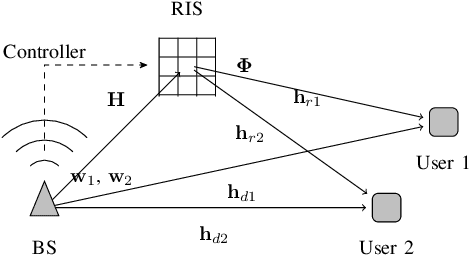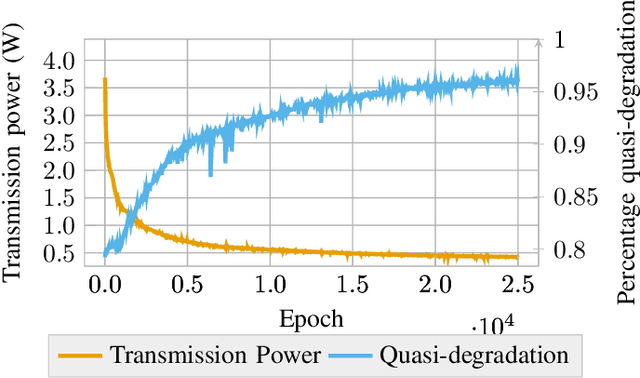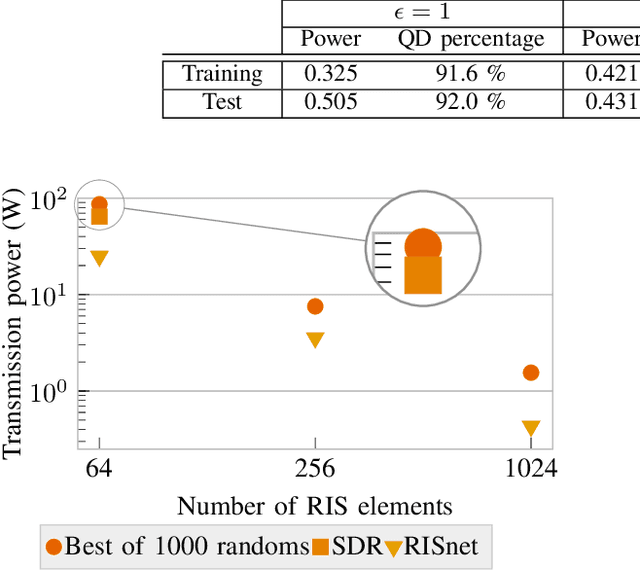Finn Siegismund-Poschmann
RIS-Assisted NOMA with Partial CSI and Mutual Coupling: A Machine Learning Approach
Aug 12, 2025Abstract:Non-orthogonal multiple access (NOMA) is a promising multiple access technique. Its performance depends strongly on the wireless channel property, which can be enhanced by reconfigurable intelligent surfaces (RISs). In this paper, we jointly optimize base station (BS) precoding and RIS configuration with unsupervised machine learning (ML), which looks for the optimal solution autonomously. In particular, we propose a dedicated neural network (NN) architecture RISnet inspired by domain knowledge in communication. Compared to state-of-the-art, the proposed approach combines analytical optimal BS precoding and ML-enabled RIS, has a high scalability to control more than 1000 RIS elements, has a low requirement for channel state information (CSI) in input, and addresses the mutual coupling between RIS elements. Beyond the considered problem, this work is an early contribution to domain knowledge enabled ML, which exploit the domain expertise of communication systems to design better approaches than general ML methods.
RISnet: A Domain-Knowledge Driven Neural Network Architecture for RIS Optimization with Mutual Coupling and Partial CSI
Mar 06, 2024



Abstract:Multiple access techniques are cornerstones of wireless communications. Their performance depends on the channel properties, which can be improved by reconfigurable intelligent surfaces (RISs). In this work, we jointly optimize MA precoding at the base station (BS) and RIS configuration. We tackle difficulties of mutual coupling between RIS elements, scalability to more than 1000 RIS elements, and channel estimation. We first derive an RIS-assisted channel model considering mutual coupling, then propose an unsupervised machine learning (ML) approach to optimize the RIS. In particular, we design a dedicated neural network (NN) architecture RISnet with good scalability and desired symmetry. Moreover, we combine ML-enabled RIS configuration and analytical precoding at BS since there exist analytical precoding schemes. Furthermore, we propose another variant of RISnet, which requires the channel state information (CSI) of a small portion of RIS elements (in this work, 16 out of 1296 elements) if the channel comprises a few specular propagation paths. More generally, this work is an early contribution to combine ML technique and domain knowledge in communication for NN architecture design. Compared to generic ML, the problem-specific ML can achieve higher performance, lower complexity and symmetry.
Non-Orthogonal Multiple Access Assisted by Reconfigurable Intelligent Surface Using Unsupervised Machine Learning
May 01, 2023



Abstract:Nonorthogonal multiple access (NOMA) with multi-antenna base station (BS) is a promising technology for next-generation wireless communication, which has high potential in performance and user fairness. Since the performance of NOMA depends on the channel conditions, we can combine NOMA and reconfigurable intelligent surface (RIS), which is a large and passive antenna array and can optimize the wireless channel. However, the high dimensionality makes the RIS optimization a complicated problem. In this work, we propose a machine learning approach to solve the problem of joint optimization of precoding and RIS configuration. We apply the RIS to realize the quasi-degradation of the channel, which allows for optimal precoding in closed form. The neural network architecture RISnet is used, which is designed dedicatedly for RIS optimization. The proposed solution is superior than the works in the literature in terms of performance and computation time.
RISNet: a Dedicated Scalable Neural Network Architecture for Optimization of Reconfigurable Intelligent Surfaces
Dec 06, 2022Abstract:The reconfigurable intelligent surface (RIS) is a promising technology for next-generation wireless communication. It comprises many passive antennas, which reflect signals from the transmitter to the receiver with adjusted phases without changing the amplitude. The large number of the antennas enables a huge potential of signal processing despite the simple functionality of a single antenna. However, it also makes the RIS configuration a high dimensional problem, which might not have a closed-form solution and has a high complexity and, as a result, severe difficulty in online real-time application if we apply iterative numerical solutions. In this paper, we introduce a machine learning approach to maximize the weighted sum-rate (WSR). We propose a dedicated neural network architecture called RISNet. The RIS optimization is designed according to the RIS property of product and direct channel and homogeneous RIS antennas. The architecture is scalable due to the fact that the number of trainable parameters is independent from the number of RIS antennas (because all antennas share the same parameters). The weighted minimum mean squared error (WMMSE) precoding is applied and an alternating optimization (AO) training procedure is designed. Testing results show that the proposed approach outperforms the state-of-the-art block coordinate descent (BCD) algorithm. Moreover, although the training takes several hours, online testing with trained model (application) is almost instant, which makes it feasible for real-time application. Compared to it, the BCD algorithm requires much more convergence time. Therefore, the proposed method outperforms the state-of-the-art algorithm in both performance and complexity.
 Add to Chrome
Add to Chrome Add to Firefox
Add to Firefox Add to Edge
Add to Edge